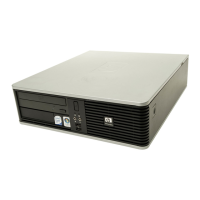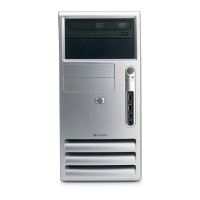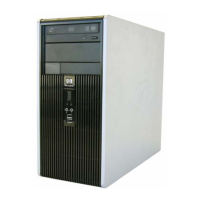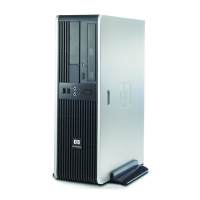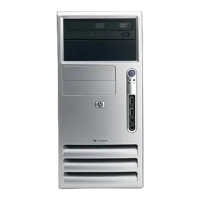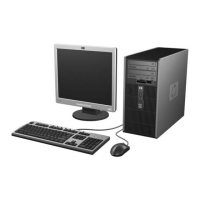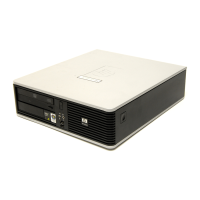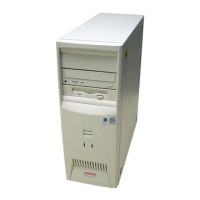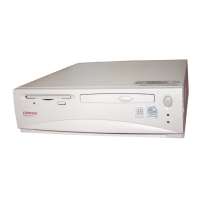Security Functions (continued)
To change a Power-On or Setup password:
1. Turn on or restart the computer. If you are in Windows, click Start > Shut Down >
Restart the Computer. Run Computer Setup (F10).
2. To change the Power-On password, go to step 3.
To change the Setup password, as soon as the computer is turned on, press and hold the
F10 key until you enter Computer Setup. Press Enter to bypass the title screen, if neces-
sary.
3. When the key icon appears, type the current password, a slash (/) or alternate delimiter
character, the new password, another slash (/) or alternate delimiter character, and the new
password again as shown: current password/new password/new password
4. Press Enter.
The new password will take effect the next time the computer is restarted.
To delete a password using Setup:
1. Turn on or restart the computer. If you are in Windows, click Start > Shut Down >
Restart the Computer.
2. To delete the Power-On password, go to step 3.
To delete the Setup password, as soon as the computer is turned on, press and hold the
F10 key until you enter Computer Setup. Press Enter to bypass the title screen, if neces-
sary.
3. When the key icon appears, type the current password followed by a slash (/) or alternate
delimiter character as shown: current password/
4. Press Enter.
NOTES:
[1] For more information about Setup Utilities refer to the Computer Setup Guide.
[2] Available on some models.
Diagnostic Functions
Diagnostic functions are provided by the Setup Utility (in system ROM) and by Diagnostics
for Windows. Diagnostics for Windows provides detailed system information including:
• Processor type and speed
• Memory amount, mapping, and integrity
• Hardware peripheral availability/settings
• Hard drive type, space used/available
• System identification, asset tracking
Diagnostics for Windows may be pre installed on some models and can be downloaded free of
charge from www.hp.com.
Error Conditions and Messages
NOTE: Beeps will occur only for 5 iterations and then stop. LEDs will continue to blink
until corrective action is taken.
Security Features
Feature Purpose
How It Is
Established
Pre-Boot Authori-
zation
Allows you to enable/disable the Smart
Card to be used in place of the Power-On
Password.
Setup Utilities. [1]
Embedded Secu-
rity [2]
Allows you to enable/disable the Embed-
ded Security device, and reset the device to
Factory Settings.
Setup Utilities. [1]
Network Service
Boot
Enables/disables the computer’s ability to
boot from an operating system installed on
a network server. (Feature available on NIC
models only; the network controller must
reside on the PCI bus or be embedded on
the system board.)
Setup Utilities. [1]
Device Security Enables/disables serial ports, parallel port,
front USB ports, system audio, network
controllers (some models), MultiBay
devices (some models), and SCSI control-
lers (some models).
Setup Utilities. [1]
Power-On Pass-
word
Prevents use of computer until password is
entered. Can apply to both initial startup
and restart.
Setup Utilities. [1]
Setup Password Prevents reconfiguration of computer until
password is entered.
Setup Utilities. [1]
DriveLock Prevents unauthorized access to data on
drives supporting password protection.
Setup Utilities. [1]
Smart Cover [2] Allows you to enable/disable the Cover
Lock, enable/disable the Cover Removal
Sensor.
Setup Utilities. [1]
Master Boot
Record (MBR)
Security
May prevent unintentional or malicious
changes to MBR of the current bootable
disk and provides a means of recovering
“last known” parameters.
Setup Utilities. [1]
Save Master Boot
Record
Saves a backup copy of the Master Boot
Record of the current bootable disk.Only
appears if MBR Security is enabled.
Setup Utilities. [1]
Restore Master
Boot Record
Restores the backup Master Boot Record to
the current bootable disk.
Setup Utilities. [1]
Drive Protection
System (DPS
Diagnostic tool built into hard drives on
select models designed to discover prob-
lems that might result in unwarranted drive
replacement.
Setup Utilities or
Diagnostics for Win-
dows.
Memory Change
Alerts
Detects addition or removal of memory
modules. Notifies system administrator.
Refer to Intelligent
Manageability
Guide.
System IDs Allows you to set: Asset Tag, Ownership
Tag, chassis serial number or Universal
Unique Identifier (UUID) number, key-
board locale setting.
Setup Utilities. [1]
Kensington
CableLock Provi-
sion
Inhibits access to interior of computer chas-
sis. Can also be used to secure computer to
a fixed object for prevent theft.
Requires Kensington
cable lock accessory
to secure computer
to a fixed object.
Security Loop
Provision
Inhibits access to the interior of the com-
puter to prevent unwanted configuration
changes or component removal.
Install a lock in the
security loop to pre-
vent unwanted con-
figuration changes
or component
removal.
Keyboard Light Combinations Used by Boot Block ROM
Failsafe
Boot Block
ROM
Keyboard
LED Color
Keyboard
LED
Activity State/Message
NumLock Green On ROMPaq diskette or ROMPaq CD not present,
is bad, or drive not ready
Caps Lock Green On Enter password.
Num, Caps,
Scroll Lock
Green Blink on in
sequence,
one-at-a-
time-N,C,SL
Keyboard locked in network mode.
Num, Caps,
Scroll Lock
Green On Boot Block ROM Flash successful. Turn
power off, then on to reboot.
*Diagnostic lights do not flash on USB keyboards
POST Diagnostic Front Panel LEDs and Audible Codes
Power LED # Beeps Event
Steady green None System on (normal operation)
Blinks green every 2 seconds None Suspend to RAM
Blinks red 2 times 2 Processor thermal shutdown
Blinks red 3 times 3 Processor not seated / installed
Blinks red 4 times 4 Power supply failure
Blinks red 5 times 5 Pre-video memory error
Blinks red 6 times 6 Pre-video graphics error
Blinks red 7 times 7 PCA failure
Blinks red 8 times 8 Invalid ROM checksum (error)
Blinks red 9 times 9 Wrong power supply input voltage
Blinks red10 times 10 Bad option card
None None System unable to power on.
Common POST Error Messages
Screen
Message Probable Cause Recommended Action
101-Option
ROM Error
System ROM or expan-
sion board option ROM
checksum.
Verify the correct ROM.
Flash the ROM if needed.
If an expansion card was recently added, remove it
and see if the problem remains.
Clear CMOS.
If the message disappears, there may be a problem
with the expansion card.
Replace the system board.
110-Out of
Memory
Space for
Option
ROMs
Recently added PCI
expansion card contains
an option ROM too
large to download dur-
ing POST.
If a PCI expansion card was recently added,
remove it to see if the problem remains.
In Computer Setup, disable the NIC PXE Option
ROM Download to prevent PXE option ROM for
the internal NIC from being downloaded during
POST to free more memory for an expansion card’s
option ROM. Internal PXE option ROM is used for
booting from the NIC to a PXE server.
Enable the ACPI/USB Buffers @ Top of Memory
setting in Computer Setup.
164-Mem-
ory Size
Error
Memory amount has
changed since the last
boot (memory added or
removed).
----------------------------
Memory configuration
is incorrect.
Press the F1 key to save the memory changes.
-----------------------------------------------------
Run Computer Setup (F10 Setup).
Make sure memory module(s) (if any) are installed
properly.
If third party memory has been added, test using
HP-only memory.
Verify proper memory module type.
201-Mem-
ory Error
RAM failure Run Computer Setup (F10 Setup) or Windows util-
ities.
Ensure memory and continuity modules are
installed correctly.
Verify proper memory module type.
Remove and replace memory module(s) one at a
time to isolate faulty module.
Replace the faulty memory module(s).
If error persists after replacing memory modules,
replace the system board.
301-Key-
board Error
Keyboard failure. Reconnect keyboard with computer turned off.
Check connector for bent or missing pins.
Ensure that none of the keys are depressed.
Replace keyboard.
501-Display
Adapter Fail-
ure
Graphics controller. Reseat the graphics card (if applicable).
Clear CMOS.
Verify that the monitor is attached and turned on.
Replace the graphics controller (if applicable).
601-Dis-
kette Con-
troller Error
Diskette controller cir-
cuitry or floppy drive
circuitry incorrect.
Run Computer Setup (F10 Setup).
Check and/or replace cables.
Clear CMOS.
Replace diskette drive.
Replace the system board.
1720-
SMART
Hard Drive
Detects
Imminent
Failure
Hard drive is about to
fail. (Some hard drives
have a firmware patch
that will fix an errone-
ous error message.)
Determine if hard drive is giving correct error mes-
sage. Run the Drive Protection System test if appli-
cable.
Apply firmware patch if applicable. (see
www.hp.com/support)
Back up contents and replace hard drive.
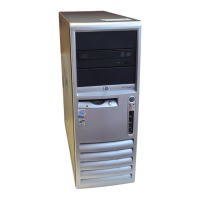
